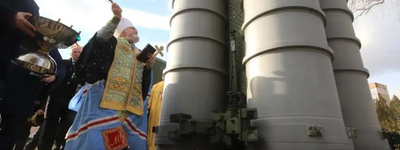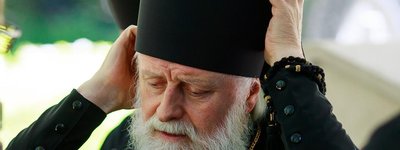March: about the struggle between the “lower” and “upper”
Interesting that at the same time the newly elected president calls for God’s help, the prime minister consecrates his cabinet, the minister of culture drives out spirits from his, and in the country every day an average of two new religious communities and almost 2.5 thousand churches are created, the number of christenings in many oblasts equals to the number of newborns, hierarchs publicly bless representatives of the government and announce their own political and even geopolitical agendas… In Ukraine there is not one public figure who would decisively proclaim himself an atheist, instead about their religious convictions politicians, sportsmen, and show business stars try to outdo one another. What in the world incites researchers to speak about the irreversible course of secularization?
It seems that above all this ineradicable confidence that once everything was different, that our great-grandparents, not even to mention our ancestors, were not only more devout, but also “genuinely” devout. It should be perceived as its own type the necessary alternate of the circumstance that most communities in their evaluation of religiosity believe that the level of their modern religious culture undergoes successive erosion, and that their devoutness declines and is incomparable with that which was demonstrated by earlier generations. Almost every century we see complaints about the decline of the society’s morals and nothing like the religious zealousness of the “old days.” If to talk about our great-grandparents, then let’s turn our attention as an example, one of many similar works, to the work of A. Schmidt “Materials for Geography and Statistics of Russia Compiled by Officers of General Staff. Kherson Province.” The author writes that religious enthusiasm of Ukrainians of southern Ukraine in the second half of the 19th century died down when superstitions flourished: the Ukrainian believes in the existence of witches, house spirits, the evil eye, is sufficiently certain in the efficacy of fortune telling. Even more critical remarks we find in the records of bishops and eparchial missionaries. They constantly complained about the peasants, who were forced to go to church on so-called “tsarist days” and who don’t go to confession, and about the landowners, who through/due to banquets, hunting, and merriment forget about the higher being.
The American religious sociologist Rodney Stark in his great piece “Secularization: RIP” (1999) produces a large number of eloquent facts and research that attest: Medieval and Early Modern Europe did not know a “Golden Age” of exemplary devoutness. Contemporaries recognize both the absence of interest of regular people to attend church and the attempt of the aristocracy to skip Sunday Mass, and weak knowledge by priests the basics of the faith (one of many examples: in the year 1551 a bishop of the English Gloucester ascertained that of the 311 priests in his eparchy 171 could not name all Ten Commandments and 27 did not know the author of the Lord’s Prayer).
Subjective perception – including the perception of mass consciousness can be very deceptive. A well-known example: when the press gave confirmation about the constant, steady, and rapid fall in the level of religiousness in the post-war French society, the research of sociologists did not allow this to be talked about this so definitely. And on the contrary, in spite of the fact that the majority of residents of all the post-Soviet countries feel that the number of religious persons in their countries is steadily growing, religious practices here remain practically unchanged.
Now let’s recall that what the church was 200 or 300 years ago; it was an obligatory, not an optional, so to say, institute. To enter this world, to start a family, and leave for a world better outside the church was not possible: the church for the resident of the Ukrainian (and, of course, not only Ukrainian) village was a registry office, club, theater, and mass media, and an official state establishment. Let’s also recall that for the villager, who in the summer worked six days a week without rest in the field, the hours during Sunday Mass were the only time to rest outside of sleep. Therefore, above all, we have to critically react to the widespread thesis about today’s “laicization” of religion. It fact, on the contrary: the church, at least in Europe, last century maybe for the first time acquired the possibility to become just the Church and engage not in life on earth, but in transcendentalism. It is necessary to consider not the fall of religious practice, but, for example, that almost every fifth compatriot at least once a month attends church, which for me is rather impressive. Consider the modern citizen, who on Sunday is directed to the morning Liturgy, has countless alternatives that his forefather simply did not. Not only the plurality of religious and quasi-religious beliefs, but also the countless amusement possibilities that are available for the person on Sunday morning and a bunch of errands which he didn’t finish during the week competes with the traditional church. And notice the absence of rigid social control, which still 100 years ago dictated a person’s certain norms of behavior and kept him from acting disapprovingly.
And now let’s turn to something else. The post-Soviet societies that went through the experiment of uprooting traditional institutional religiosity and where the participation of religious institutes in the process of socialization for at least three generations was contracted to the minimum, suggesting excessive requirements to the religiosity of their fellow citizens. Indeed, in the scholarly study of religion the five dimensions of religiosity introduced by Charles Glock practically became classical: religious faith, religious experience, religious knowledge, church and ritual practice, and the dimension of ethical results of faith. Around these dimensions is a long scholarly discussion, but maybe only in post-Soviet countries the school Glock is perceived not as an instrument in the instrumentalization of religious manifestations, but as an adequate standard, which has to correspond to the studied bearer of religiosity. In the mass consciousness is embedded the image of a “true believer,” who consistently fulfills all the religious instructions, unconditionally believes in the fundamental dogmatic principles of his church, regularly attends divine service, has sound religious knowledge, and demonstrates a high moral behavior. The inaccessibility of such an “ideal type” even in some approximation forms a conception about the “inferiority” of the religiosity of Ukrainians. In reality, if we approach most monks and nuns with such requirements then they could turn out to be “not true believers.”
In fact, the integrated index of religiosity of Ukrainians (religious behavior, religious knowledge, individual devotion, religious-institutional attraction), put forth in the coordinates of central and eastern European societies, attests about the “normality” of this religiosity. Ukraine lags behind, certainly, Hungary and Slovakia, not to mention Romania and Poland, but leaves behind Czech Republic, Latvia, Estonia, and Belarus.
Further: with this empirical base, by which operates our modern sociology of religion, to make a conclusion about whether the modernity of religion is being undermined or not is not possible; the concept about linear historic decline of religion is also not confirmed by research. A known example is that the U.S. citizen in 1800 attended church less frequently than he does now. Regarding the past we can talk also about a few waves of “religious returns”; one which began in the last quarter of the 20th century and still today to a great extent determines the world’s religious development; this “return” includes a lift in the conservative wave in the world’s Protestantism, fundamentalist waves like in the big (Islam, Buddhism, Hinduism) and in the national (Sikhism and Judaism) religions, the Muslim Revolution in Iran, a national explosion directed against the ruling regimes, Catholicism in South and Central America, Poland, the Philippines, and in South Africa; the extensive spread of new religious movement in North America and Western Europe, and also the recreation of religion into a significant factor for national and cultural mobilization in post-Soviet countries, including Ukraine.
Nonlinearity of religious behavior is inherent and social, and for individual people. The rigid distinction “believer – non-believer” cannot be considered correctly and suitably for scholarly use. In certain vital situations the person turns to religion or, on the contrary, turns away from it. By certain circumstance entire societies extract from religion a sense, a driving force for its development, symbols, and demarcation markers. Such appeals we see in the English of the 18-19th centuries, who separate themselves by their Puritanism from “French frivolity and perversion,” or in the Irish whose national formation was accompanied by a “pious revolution.” On the other hand, societies are able to refuse from religious causes even when religion composed the core of the collective myth and was the main factor that for centuries differentiated a community from others (like this was in the process of forming a modern Turkish nation, for example). The fall of communism, which was accompanied by the erosion of old identities, called forth the appeal to religion as a reliable system of values and national-cultural depository. At the same time, such appeals are able to be changed (and really change) by periods of “religious cooling.”
A person, like once aphoristically indicated the surgeon Mykola Amosov, is not only who he is to the belt, but also that which is lower. We are all, certainly, decayed creations, and we all carry in ourselves the reflection of God’s likeness. That which is “lower,” fights with that which is “higher” and this struggle will last, evidently, for all of human’s history.










